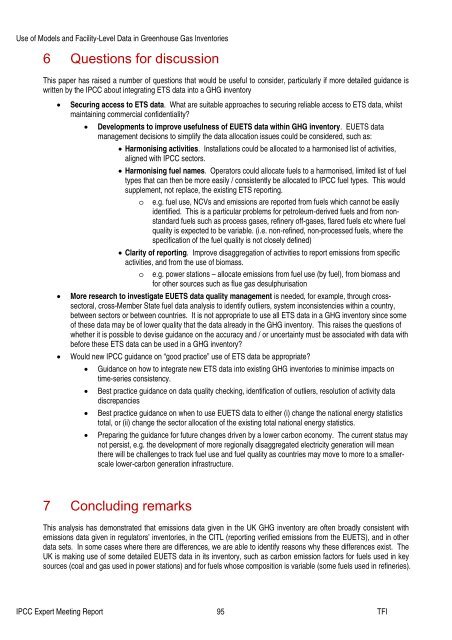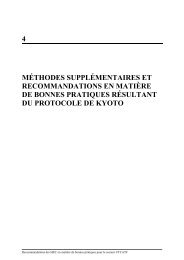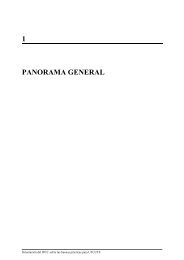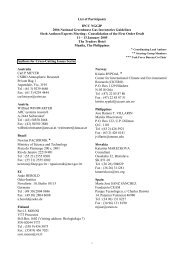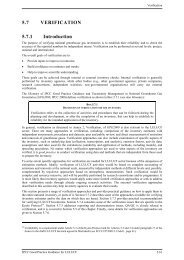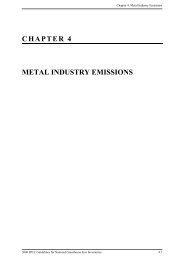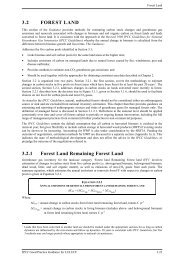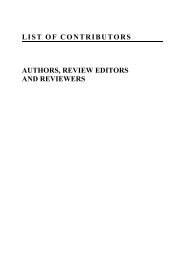Use of Models and Facility-Level Data in Greenhouse Gas Inventories
Use of Models and Facility-Level Data in Greenhouse Gas Inventories
Use of Models and Facility-Level Data in Greenhouse Gas Inventories
You also want an ePaper? Increase the reach of your titles
YUMPU automatically turns print PDFs into web optimized ePapers that Google loves.
<strong>Use</strong> <strong>of</strong> <strong>Models</strong> <strong>and</strong> <strong>Facility</strong>-<strong>Level</strong> <strong>Data</strong> <strong>in</strong> <strong>Greenhouse</strong> <strong>Gas</strong> <strong>Inventories</strong><br />
6 Questions for discussion<br />
This paper has raised a number <strong>of</strong> questions that would be useful to consider, particularly if more detailed guidance is<br />
written by the IPCC about <strong>in</strong>tegrat<strong>in</strong>g ETS data <strong>in</strong>to a GHG <strong>in</strong>ventory<br />
• Secur<strong>in</strong>g access to ETS data. What are suitable approaches to secur<strong>in</strong>g reliable access to ETS data, whilst<br />
ma<strong>in</strong>ta<strong>in</strong><strong>in</strong>g commercial confidentiality?<br />
• Developments to improve usefulness <strong>of</strong> EUETS data with<strong>in</strong> GHG <strong>in</strong>ventory. EUETS data<br />
management decisions to simplify the data allocation issues could be considered, such as:<br />
• Harmonis<strong>in</strong>g activities. Installations could be allocated to a harmonised list <strong>of</strong> activities,<br />
aligned with IPCC sectors.<br />
• Harmonis<strong>in</strong>g fuel names. Operators could allocate fuels to a harmonised, limited list <strong>of</strong> fuel<br />
types that can then be more easily / consistently be allocated to IPCC fuel types. This would<br />
supplement, not replace, the exist<strong>in</strong>g ETS report<strong>in</strong>g.<br />
o e.g. fuel use, NCVs <strong>and</strong> emissions are reported from fuels which cannot be easily<br />
identified. This is a particular problems for petroleum-derived fuels <strong>and</strong> from nonst<strong>and</strong>ard<br />
fuels such as process gases, ref<strong>in</strong>ery <strong>of</strong>f-gases, flared fuels etc where fuel<br />
quality is expected to be variable. (i.e. non-ref<strong>in</strong>ed, non-processed fuels, where the<br />
specification <strong>of</strong> the fuel quality is not closely def<strong>in</strong>ed)<br />
• Clarity <strong>of</strong> report<strong>in</strong>g. Improve disaggregation <strong>of</strong> activities to report emissions from specific<br />
activities, <strong>and</strong> from the use <strong>of</strong> biomass.<br />
o e.g. power stations – allocate emissions from fuel use (by fuel), from biomass <strong>and</strong><br />
for other sources such as flue gas desulphurisation<br />
• More research to <strong>in</strong>vestigate EUETS data quality management is needed, for example, through crosssectoral,<br />
cross-Member State fuel data analysis to identify outliers, system <strong>in</strong>consistencies with<strong>in</strong> a country,<br />
between sectors or between countries. It is not appropriate to use all ETS data <strong>in</strong> a GHG <strong>in</strong>ventory s<strong>in</strong>ce some<br />
<strong>of</strong> these data may be <strong>of</strong> lower quality that the data already <strong>in</strong> the GHG <strong>in</strong>ventory. This raises the questions <strong>of</strong><br />
whether it is possible to devise guidance on the accuracy <strong>and</strong> / or uncerta<strong>in</strong>ty must be associated with data with<br />
before these ETS data can be used <strong>in</strong> a GHG <strong>in</strong>ventory?<br />
• Would new IPCC guidance on “good practice” use <strong>of</strong> ETS data be appropriate?<br />
• Guidance on how to <strong>in</strong>tegrate new ETS data <strong>in</strong>to exist<strong>in</strong>g GHG <strong>in</strong>ventories to m<strong>in</strong>imise impacts on<br />
time-series consistency.<br />
• Best practice guidance on data quality check<strong>in</strong>g, identification <strong>of</strong> outliers, resolution <strong>of</strong> activity data<br />
discrepancies<br />
• Best practice guidance on when to use EUETS data to either (i) change the national energy statistics<br />
total, or (ii) change the sector allocation <strong>of</strong> the exist<strong>in</strong>g total national energy statistics.<br />
• Prepar<strong>in</strong>g the guidance for future changes driven by a lower carbon economy. The current status may<br />
not persist, e.g. the development <strong>of</strong> more regionally disaggregated electricity generation will mean<br />
there will be challenges to track fuel use <strong>and</strong> fuel quality as countries may move to more to a smallerscale<br />
lower-carbon generation <strong>in</strong>frastructure.<br />
7 Conclud<strong>in</strong>g remarks<br />
This analysis has demonstrated that emissions data given <strong>in</strong> the UK GHG <strong>in</strong>ventory are <strong>of</strong>ten broadly consistent with<br />
emissions data given <strong>in</strong> regulators’ <strong>in</strong>ventories, <strong>in</strong> the CITL (report<strong>in</strong>g verified emissions from the EUETS), <strong>and</strong> <strong>in</strong> other<br />
data sets. In some cases where there are differences, we are able to identify reasons why these differences exist. The<br />
UK is mak<strong>in</strong>g use <strong>of</strong> some detailed EUETS data <strong>in</strong> its <strong>in</strong>ventory, such as carbon emission factors for fuels used <strong>in</strong> key<br />
sources (coal <strong>and</strong> gas used <strong>in</strong> power stations) <strong>and</strong> for fuels whose composition is variable (some fuels used <strong>in</strong> ref<strong>in</strong>eries).<br />
IPCC Expert Meet<strong>in</strong>g Report 95 TFI


